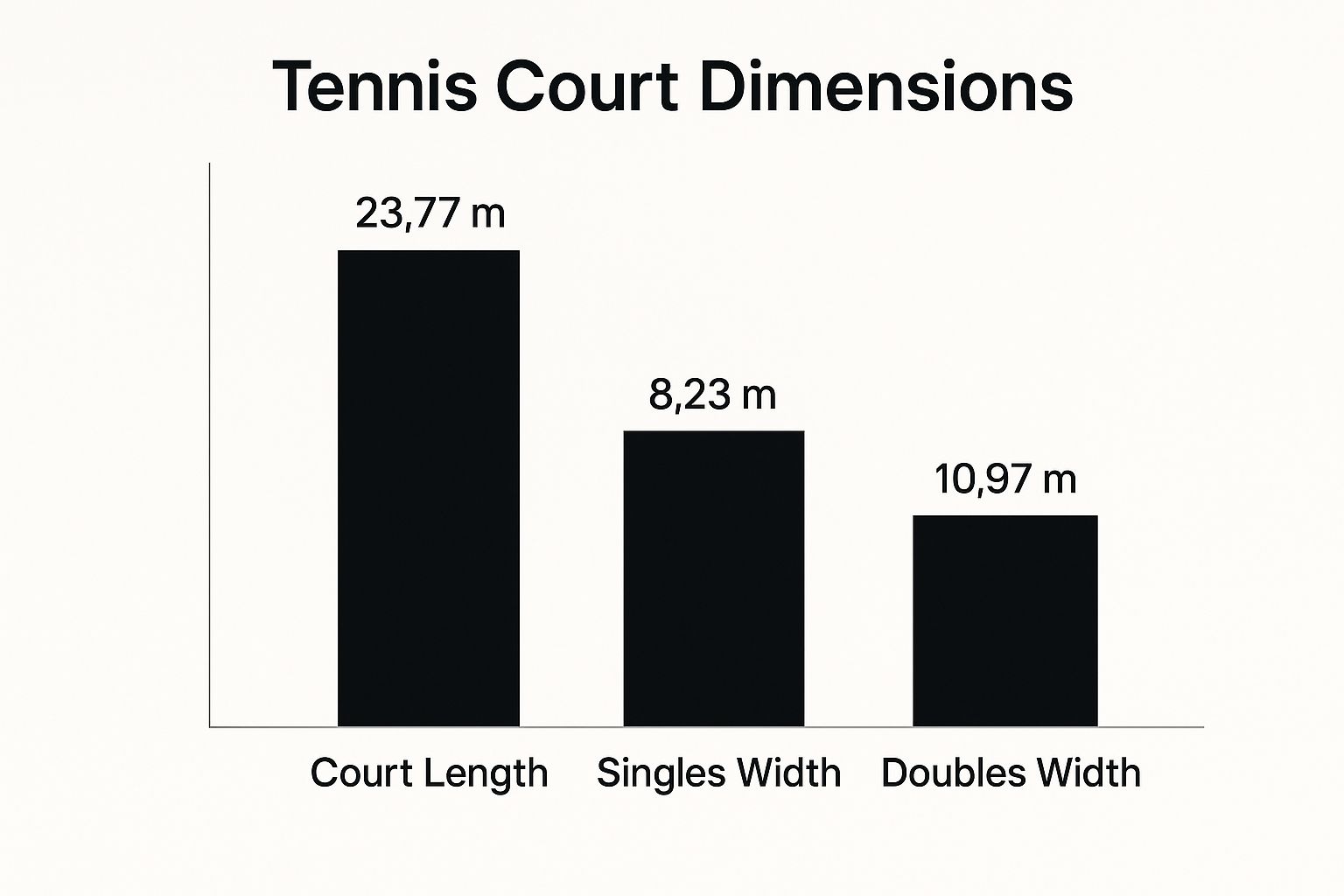
When you step onto a tennis court, you're stepping into a space with a history and a very specific set of rules, starting with the tennis court size. Every official court, anywhere in the world, shares the exact same length: 78 feet (23.77 metres). As experts in the sport, we at Mantis believe understanding the court is the first step to mastering it, which is why we provide a full range of professional tennis equipment for every level of play.
What does change, however, is the width. A court set up for a singles match is 27 feet (8.23 metres) wide. For doubles, the court expands to 36 feet (10.97 metres), using the outer tramlines. This consistency is what makes tennis a truly global sport, ensuring a level playing field from your local club to Centre Court at Wimbledon.
If you're thinking about building or upgrading a court, getting these dimensions right is the first, most crucial step. You can explore our complete range of professional tennis equipment to ensure everything is up to standard.
Decoding the Official Tennis Court Size Dimensions
A tennis court isn't just a patch of grass or clay; it's a precisely measured arena where every inch influences the game. These dimensions aren't random. They’ve been refined over more than a century to create the perfect balance of challenge and playability, ensuring fairness no matter where a match is held. To us at Mantis, these details matter, as they form the foundation of the sport we love, much like the history behind the official regulation tennis court size.
The standardisation of court size was a game-changer for tennis as it grew in popularity. It meant that a player's skill, not the quirks of a particular court, would decide the outcome. You can actually trace the history of these measurements and see how they’ve evolved over time.
Key Court Measurements Visualised
Sometimes, seeing the numbers in a diagram makes it all click. This visual breaks down the core measurements that define the playing area.

As you can see, the length is constant, but that extra 9 feet of width in a doubles match completely changes the angles and strategies players use.
At its heart, a tennis court is a rectangle defined by specific, non-negotiable measurements. This uniformity is what allows a player in London to compete on the exact same geometric playing field as a player in Tokyo.
For anyone planning a new court or simply re-marking an old one, sticking to these official dimensions is non-negotiable. Every line, from the baseline to the service box, has a purpose, and it all fits within this carefully defined space.
Official Tennis Court Dimensions at a Glance
To make it even simpler, here's a quick-reference table with all the key dimensions you need, whether you're measuring for a singles or doubles court.
| Court Area | Length (feet) | Width (feet) | Length (metres) | Width (metres) |
|---|---|---|---|---|
| Singles Court | 78 | 27 | 23.77 | 8.23 |
| Doubles Court | 78 | 36 | 23.77 | 10.97 |
This table neatly summarises the fundamental layout. Having these numbers handy is essential for anyone involved in court construction, maintenance, or even just for players who want to deepen their understanding of the game.
How to Read the Lines on a Tennis Court
Think of the lines on a tennis court as more than just boundaries. They're a strategic map, the very grammar of the game. Here at Mantis, we believe that understanding what each line means is just as crucial as knowing the official regulation tennis court size. When you get it, you'll see the game in a whole new light.
These white lines dictate the entire flow of a match, creating different zones with their own rules. It’s not simply about keeping the ball inside a box; it’s about establishing the tactical puzzles that make every point a unique challenge.
Core Lines and Their Functions
Every line has a distinct job, and together they build the structure for every shot. Getting to grips with their roles is the first step to truly appreciating the sport's tactical depth.
- The Baseline: This is the big line at the very back of the court. It sets the furthest limit for play and, crucially, it's the line you must stand behind when you serve.
- The Sidelines: Running down the length of the court, these lines mark the side boundaries. The inner pair defines the court for singles, while the wider, outer pair is used for doubles matches.
- The Service Line: This line runs parallel to the net and is positioned 21 feet (6.4 metres) away from it. For a serve to be 'in', it must land in the area between the net and this line.
Strategic Lines Inside the Court
The lines inside the main court are where the opening strategy of every point happens, especially during the serve. They create the specific targets you need to hit to start a point correctly.
The Centre Service Line is the one that splits the area between the service lines in half, running straight from the net to the service line. This creates two identical rectangular areas on each side, which we know as the Service Boxes.
To begin any point, a player must serve the ball diagonally across the net, landing it inside the opponent's corresponding service box. This single rule is what makes the serve such a precise and skilful opening shot.
Finally, that little hash mark in the middle of the baseline is the Centre Mark. It’s a simple but vital guide, showing you where to stand on either side of it before you serve.
Getting the Net Height and Position Just Right
Think of the net as the heart of the court. If it's not set up correctly, the entire game feels off. A net that’s too high or too low can completely alter how a point is played, turning a regulation court into a bit of a free-for-all. We can’t stress this enough: getting the net height and position spot on is absolutely fundamental to honouring the official regulation tennis court size. It’s all about fairness and creating professional playing conditions.
The net is more than just a barrier; it dictates the trajectory of every shot. What many people don't realise is that its height isn't uniform from post to post. This slight difference is a deliberate and crucial feature of tennis court design.
Official Net Height Specifications
To keep things consistent from Wimbledon to your local club, the International Tennis Federation (ITF) has very precise measurements. Getting these two numbers right is the key to a perfectly set-up court.
- At the Posts: Where the net connects to the posts, the cord should be exactly 3.5 feet (1.07 metres) high.
- At the Centre: In the middle, a white strap (no wider than 2 inches) pulls the net down to a height of 3 feet (0.914 metres).
That six-inch drop in the middle isn't an accident. It's designed to give players a slightly lower target over the centre of the court, which subtly encourages cross-court rallies and dares the braver players to aim for those challenging shots down the line.
A properly tensioned net with the correct centre height ensures every player on every court faces the same geometric challenge. It’s a tiny detail that has a massive impact on the game's fairness and strategic depth.
Correct Placement of the Net Posts
Just as critical as the net's height is where the posts stand. You can't just place them anywhere. According to the rules, the posts must be positioned 3 feet (0.914 metres) outside the doubles sidelines.
This precise placement guarantees the net spans the full width needed for doubles play, keeping the tension and height consistent across the entire playing surface. It’s a small but vital detail that makes a court work for both singles and doubles matches.
Planning for Space Beyond the Baselines
Anyone who’s played seriously knows the game of tennis doesn't stop at the painted lines. While the court's dimensions are set in stone, the space around the court is just as vital for safety and high-level play. It’s a detail we at Mantis always stress when helping people plan a new court, because getting it right is fundamental to a proper setup. You can see how other factors influence the game in our guide to tennis court surfaces.
Think of this extra room as the court's active arena. It’s what gives players the freedom to sprint for a wide-angle shot or chase down a deep lob without worrying about crashing into a fence or wall. For a safe and truly competitive environment, this run-off space isn't just a nice-to-have; it's essential.
Official Run-Off Recommendations
So, how much space are we talking about? The International Tennis Federation (ITF) sets out clear guidelines for tournament play, ensuring players have enough room to move at full tilt without risk.
- Behind the Baselines: A minimum of 21 feet (6.4 metres) is recommended between the baseline and the back fence.
- Along the Sidelines: You need at least 12 feet (3.66 metres) from the doubles sidelines to any side obstruction.
When you do the maths, the total recommended footprint for a single, tournament-standard court comes out to 120 feet (36.57 metres) long by 60 feet (18.29 metres) wide.
This is where the most athletic and dramatic points happen. It’s the difference between a player attempting a spectacular running passing shot and having to pull up short, giving up the point to avoid injury.
Why This Space Matters for Every Court
Even if you're building a court for a club or just for fun at home where space might be tight, you should still aim to maximise the run-off area as much as possible. It has a direct impact on player safety and, frankly, how much fun the court is to play on.
A court with cramped surroundings feels restrictive. It can subconsciously discourage players from going for their shots near the boundaries. In the end, planning for ample room beyond the lines ensures your court isn't just built to spec, but is a safe, enjoyable, and genuinely competitive space for everyone who uses it.
The Surprising History of Court Standardisation
Ever stood on a tennis court and wondered why it’s that specific shape and size? It feels like it’s been that way forever, but the modern, globally recognised regulation tennis court we all know wasn't just invented overnight. Here at Mantis, we reckon that knowing the sport's heritage adds a little something extra to every match, and the court's own story is a fascinating tale of practicality meeting progress. It even ties into how we choose the best different tennis court surfaces for our game.
The path to a standard court really starts back in the 19th century. In the early days of lawn tennis, people played on all sorts of court shapes. Some were even wider at the baselines and squeezed in at the net, creating a strange "hourglass" figure. You can imagine how trying to have a fair competition between different clubs was a bit of a nightmare.
From Croquet Lawns to a Global Standard
So, where did our familiar rectangle come from? The answer, surprisingly, is croquet. As tennis grew in popularity across the UK, it was often played on existing croquet lawns. It just made sense to mark out a rectangular court that would fit neatly within those boundaries.
This practical approach became official when the All England Lawn Tennis and Croquet Club decided to host its very first championship back in 1877. For the tournament, they set down specific rules, which included the court's dimensions. Those measurements—78 feet long by 27 feet wide for singles—worked so well that they've stuck around ever since. It was a simple, pragmatic decision that became the bedrock of modern tennis.
The dimensions chosen for the first Wimbledon Championships in 1877 weren't the result of some grand scientific study. They were a practical solution that just happened to create a perfectly balanced playing field—one that has stood the test of time for nearly 150 years.
The Role of Governing Bodies
As tennis fever swept the globe, it became obvious that a single, unified set of rules was essential. This is where organisations like the All England Club and, later, the International Tennis Federation (ITF), stepped in. They were crucial in taking those Wimbledon dimensions and making them the official, worldwide standard.
Thanks to them, a player in London is competing on the exact same sized court as a player in Melbourne or New York. This standardisation was one of the most important steps in tennis's journey from a garden party game to the professional, global sport we love today, ensuring that skill, not the court's quirks, is what truly decides the winner.
Your Top Questions About Tennis Court Dimensions Answered
We've covered the official measurements, but it's natural for a few more specific questions to pop up. At Mantis, we want to make sure every detail is crystal clear, so let's tackle some of the most common queries you might have. Think of this as fine-tuning your knowledge – just as crucial as knowing how to choose a tennis racket that feels right in your hand.
This level of detail is especially important for those running tennis coaching businesses, where a deep understanding of the game's fundamentals creates a truly professional environment for both players and staff.
Are Court Sizes Different for Junior Players?
Yes, they absolutely are. The ITF has smartly introduced smaller, scaled-down courts to help young players develop their skills without feeling overwhelmed. These are broken down by age and ability:
- Red Court: For players under 8.
- Orange Court: For ages 8-9.
- Green Court: For ages 9-10.
Each stage gradually increases in size, allowing children to learn on a court that’s proportional to their own size. This makes the game more manageable, more fun, and far better for developing proper technique.
By scaling the court, young players can build solid technical and tactical skills from the very beginning. It's all about creating a strong foundation before they face the challenge of a full-sized court.
Do Court Dimensions Change with the Surface?
That's a great question, but the answer is no. The official regulation court size is universal, regardless of the surface. Whether you're sliding on clay, charging the net on grass, or playing on a hard court, the playing area is always 78 feet by 36 feet for doubles.
The only thing the surface changes is the behaviour of the ball – its speed, bounce, and how it reacts to spin. The lines and dimensions, however, stay exactly the same.
What Is the Minimum Ceiling Height for an Indoor Court?
For indoor courts, vertical space is a critical, and often overlooked, dimension. The ITF recommends a minimum clear height of 9 metres (30 feet) directly above the net to ensure play isn't obstructed.
For higher-level competitive play, a clear height of 12.2 metres (40 feet) over the entire court is the gold standard. This gives players plenty of room for high, defensive lobs without the ceiling interfering with the point.
At Mantis, we believe that understanding the field of play is the first step towards mastering it. Equip yourself with gear that honours your dedication. Explore our range of performance-focused equipment at https://mantissport.com.








